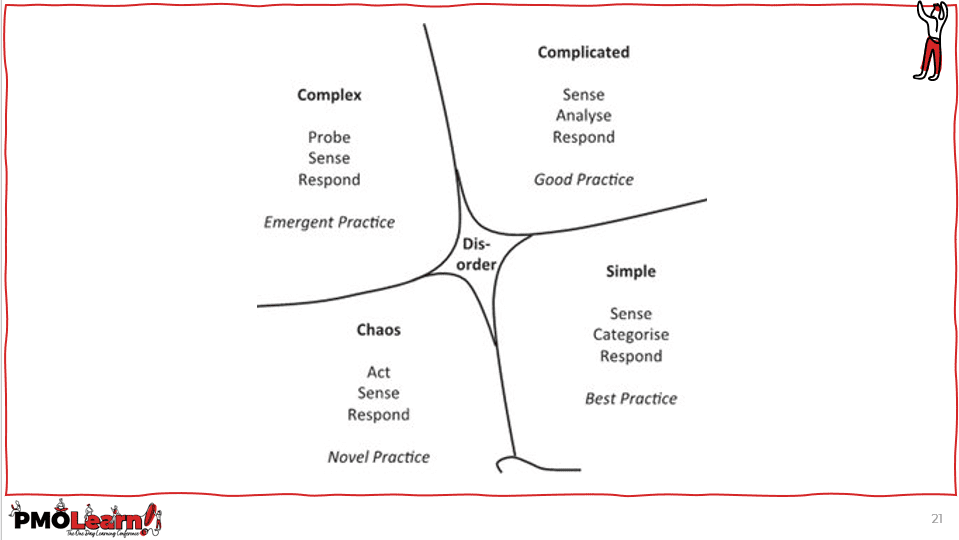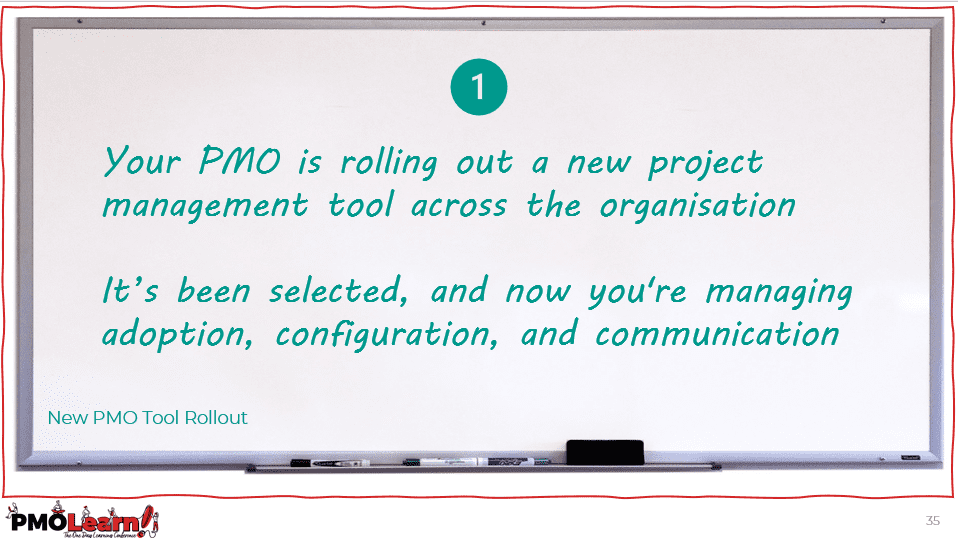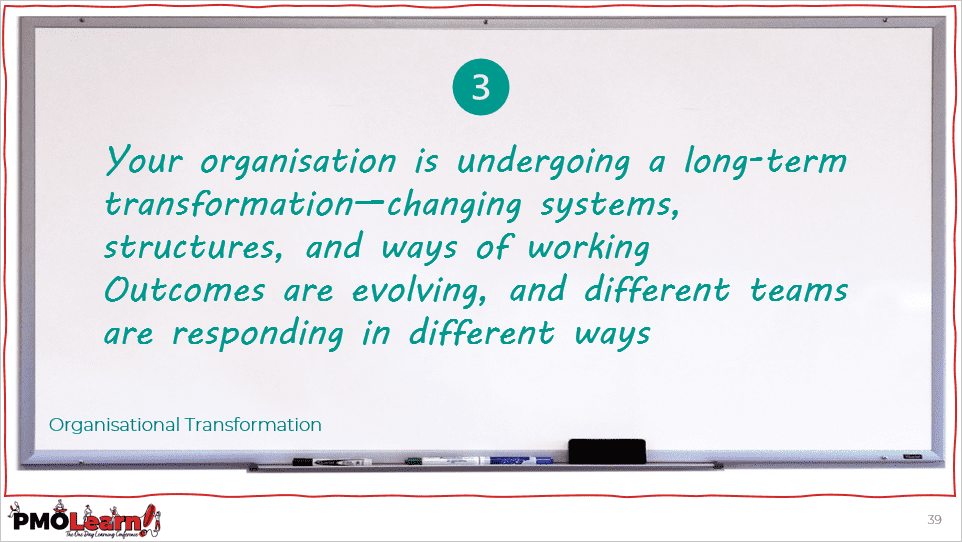Watch back all our PMO Conference sessions
The PMO Flight Plan with Cynefin – Zoe O’Toole // PMOLearn! London 2025
 PMOs today don’t operate in clear skies. From turbulence in governance to working through transformational clouds, this session led by Zoe O’Toole at PMOLearn! 2025 explored how PMOs can use the Cynefin framework to make better decisions and build the right team for the right environment.
PMOs today don’t operate in clear skies. From turbulence in governance to working through transformational clouds, this session led by Zoe O’Toole at PMOLearn! 2025 explored how PMOs can use the Cynefin framework to make better decisions and build the right team for the right environment.
The core message? You can’t use autopilot all the time – knowing when to use best practice, when to experiment, and when to take bold action is the secret to keeping your PMO flying high.
Recorded Session
Workshop Booklet
Download the WorkbookOverview of the Session
 In today’s world, PMOs aren’t just supporting delivery – they’re operating in environments that swing from stable and predictable to rapidly changing and ambiguous. The challenge? Knowing how to respond appropriately in each situation, and ensuring your PMO doesn’t apply a rigid checklist to a moving target.
In today’s world, PMOs aren’t just supporting delivery – they’re operating in environments that swing from stable and predictable to rapidly changing and ambiguous. The challenge? Knowing how to respond appropriately in each situation, and ensuring your PMO doesn’t apply a rigid checklist to a moving target.
That’s where the Cynefin framework comes in. Originally developed by Dave Snowden, Cynefin offers a way to categorise situations into domains – Simple, Complicated, Complex, and Chaotic – and match your decision-making approach accordingly.
This session focused on three core themes:
- Decision-making in context – recognising that not every problem needs a process, and not every situation benefits from best practice.
- People and environment alignment – understanding that putting the right people into the wrong context is a recipe for failure.
- Building adaptive PMOs – exploring how governance, tooling, and communication must evolve as your environment changes.
Rather than a slide-heavy lecture, Zoe’s session took the form of a guided flight through different scenarios, punctuated by audience interaction, table-based exercises, and plenty of light-hearted but thought-provoking aviation metaphors.
As Zoe put it:
“PMOs aren’t just about running tight processes – they’re about helping people and teams navigate change in a way that makes sense for the world they’re in.”
The result? A session that left delegates not only with a better understanding of how to apply Cynefin in a PMO context, but also more aware of their own instinctive decision-making styles – and how to flex them when turbulence hits.
 What is the Cynefin Framework?
What is the Cynefin Framework?
The Cynefin (pronounced kuh-NEV-in) framework is a decision-making model designed to help leaders, teams, and organisations choose the most appropriate response for different types of situations.
Developed by Dave Snowden in the early 2000s while working at IBM, the name “Cynefin” is Welsh for “habitat” or “place of belonging” a nod to the idea that understanding where you are helps you know how to act.
In PMO terms, Cynefin helps us avoid the common trap of using the same approach for every challenge. Instead, it invites us to first sense the environment, understand the nature of the problem, and respond accordingly.
The model has five domains:
- Simple (or Clear)
“We’ve seen this before.”
In this domain, the relationship between cause and effect is obvious to all. There’s a known best practice, and the right response is to sense, categorise, and respond.
Example for PMO: Producing standard weekly reports. Follow the checklist, use the template – job done.
- Complicated
“There is a right answer – we just need expertise.”
Here, cause and effect exist but aren’t immediately clear. You’ll need analysis or expert advice. There might be multiple valid solutions.
Example for PMO: Designing a bespoke benefits tracking process for a large financial services programme.
- Complex
“We’ve never seen this exact situation before.”
In a complex domain, outcomes emerge over time. There’s no obvious solution upfront – you need to probe, experiment, and learn as you go.
Example for PMO: Supporting a multi-year transformation where outcomes are still evolving.
- Chaotic
“It’s on fire—act now!”
In a chaotic environment, there’s no time to analyse. You must act to stabilise the situation, then sense what’s going on, and respond quickly.
Example for PMO: Responding to a last-minute demand from execs to realign the entire portfolio due to an urgent strategy shift.
- Disorder (the centre)
This is where you don’t know which domain you’re in yet. It’s a dangerous space – many people default to their comfort zone here.
Tip: Break the problem down into smaller parts and assign each to a domain.

In the session, Zoe took us through the different courses of action based on the domain – for example. In the Simple domain – Sense, Categorise and Respond. Sense is about observing what’s happening, Categorise is about matching what you’re seeing to known patterns and Respond is about applying known solutions. In this domain, it is about applying known best practice.
Download the deck or watch the session for explainations on the other domains.
Why Cynefin Matters for PMOs
Using Cynefin gives PMOs a practical way to tailor governance, advice, and support to the situation at hand – avoiding the trap of applying rigid process to dynamic problems, or over-engineering simple ones.
It also helps PMOs:
- Advise leaders more effectively on how to respond in uncertain times.
- Match people to context, putting the right skills and behaviours into the right environments.
- Build resilience, by becoming more adaptive in the face of change.
The Practical Session: Using Cynefin
On each table were laminated cards with the words – Complex, Complicated, Simple and Chaos. Zoe then gave a number of different PMO situations. The learners were asked to choose which domain or environment it would most closely relate to.
Here’s an exmaple:


The learners were divided on this one – is it complex or is it complicated?
The answer was complicated. There’s a clear objective, but you need some expert input, maybe from IT, change, and comms, to get it right. There are several right ways to do this, but it takes analysis, coordination, and specialist knowledge to make it land well.
And a second example:

It sounds like it might be chaos!
There isn’t one clear answer. The solution will emerge over time. You need to support learning, allow for flexibility, and avoid jumping to fixed solutions. This is where the PMO helps teams to sense what’s working and adapt as the picture becomes more clear
This exercise was a fast, practical way to explore how we make sense of situations. It’s a reminder that the way we see a problem shapes the way we respond to it. The aim isn’t to stick a label on everything but to pause, look around, and ask: what kind of environment am I in right now? That helps us choose an approach that actually works for the team, the project, and the context.
When we asked the class how many of them had come across Cynefin before, not many had – but they liked the simple framework – and the lessons certainly stuck.
Final Thought
Working together on the table we got thinking about Cynefin and the portfolio of work. It would be an interesting exercise to map what each project in your current portfolio might be classed as – do you have too many chaos, not enough complicated, is it all simple and therefore perhaps not innovative or groundbreaking.
Ready for the Quiz?
See how you get on with these questions

 What is the Cynefin Framework?
What is the Cynefin Framework?